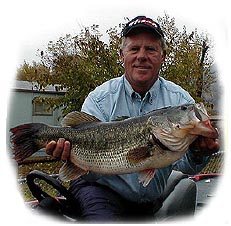
It never ceases to amaze me that bass fishermen are willing to spend hundreds of dollars on rods and reels, which can be replaced when worn-out, lost, broken or in some cases stolen. Yet when it comes to their eyesight, which is priceless, they want to scrimp on the price they pay for eye protection. And the amazing thing to me is that fishermen, especially bass fishermen, do this knowing full well that one high velocity split-shot, bullet weight or jig head striking them in a eye could leave them sightless for life.
(UV) from the sun.
The importance of quality eyewear for the avid bass fisherman or anyone that spends time in the sun cannot be overstated! Sunscreen companies, Dermatologists and the American Medical Association have had lots of publicity and have spent millions of dollars trying to educate us on the seriousness of cancer related problems from the sun. But not enough has been said about the dangers of UV rays to the eyes. Just consider this one fact: The amount of UV rays reflected from the flat surface of the water may be up to 8 times the brightness of reflected light of land.
This article will deal with the reasons for 100% UV protection plus explain why some of the best Polarized lens materials are so good. And at the same time explore the best lens color for locating bass, rocks, and stumps and weed line under water.
There is still an argument about the depletion of the ozone layer allowing more UV rays than ever before to enter our atmosphere. But no matter who's right, I believe it's better to be "safe than sorry".
The first thing to know is that UVA and UVB rays are not visible and do not register with the nerve receptors in the human eye. These are the rays that cause you to squint on cloudy days and evidence also indicates possible contributing factor in cataract and other eye aging diseases.
Polarization is like a venetian blind. The closer the slats are together the better the polarization. Some manufactures rate the polarization of their sunglasses by percentage such as 20% or 100% or as "Maximum. What this means to you when choosing polarized lens is that the higher the percentage the closer together the "slats" and the better the lens will be at blocking out the unwanted horizontal light waves or glare without shutting out the ambient light that is required for proper vision.
Blocking out the horizontal waves or glare is what allows you to see below the water's surface. All lenses must have a certain level of darkness or tint to attain good polarization. That's why you can't have polarized clear lens. For example, a dark gray or green lens has better polarization than a yellow lens. Lens tints can be made to selectively filter different colors. A gray lens filters all colors equally thus decreasing brightness. A reddish range lens for example will make red clay targets more visible for trap shooters.
For the past 2 years I have been using the "Mossback" tinted Noctular(r) lens developed by Dr. Gary Nesty and used exclusively by Solar Bat(tm) and now I understand why fish are so much more visible than with any color I've used before. This patented color enhances the greens, blacks and browns, which makes weeds, moss, rocks, stumps etc... or anything with a dark hue more visible and bleaches out tans thus making the job for the sight fisherman much easier.
Lens technology in has come a long way. The old technology using glass is now only about 4% of the entire market. They are heavier and less impact resistant. The newer hard resin lenses are lighter and more impact resistant but must have a scratch resistant coating to be durable and must be dyed to filter UV.
Space age technology has given us the polycarbonate lens, which is the optical name for Lexan. This material has natural filters for blocking UV rays. And at the same time offers much more eye protection than glass lens by being impact resistant. This is one reason why polycarbonate is the material required by OSHA for safety glasses. Plus, it's lighter than glass lens and just as scratch resistant.
So, the next time you're thinking about adding to your arsenal of fishing tools, I recommend that if you don't have a good quality pair of polarized sunglasses you consider making them your next purchase instead of that new reel.
As a footnote I would like to thank Dr. Gary Nesty and Tommy "D" Shockley for all the technical help for this article. Life is sure a learning curve!
The bass you "properly" release today is the bass you can catch tomorrow!
Keith Clow


 Advertising
Advertising